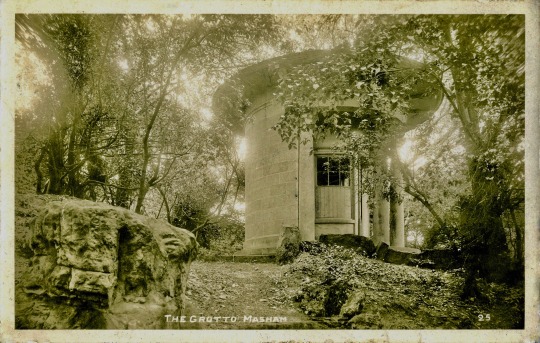#William Aislabie
Explore tagged Tumblr posts
Text
The Grotto Temple, Masham, North Yorkshire
Just over the river Ure from the market town of Masham is this unusual rotunda sitting on top of a rustic grotto. It was designed to take advantage of the view over the river to the church and the attractive little town. An engraved stone near the temple tells us that in 1770 ‘Samuel Wrather built this grotto’. Continue reading Untitled

View On WordPress
#Burrill#Dydynski#George Cuitt#Grangerisation#grewelthorpe#hackfall#Julius Caesar Ibbetson#Mary Elizabeth Stevenson#masham#Nutwith#River Ure#Samuel Wrather#St Leger#Thomas Dunham Whitaker#William Aislabie#Yorkshire
0 notes
Text
Les bois de Hackfall contiennent des follies, des monuments en pierre sans autre usage apparent que décoratif, la plupart érigées au 18ième par John Aislabie pour embellir sa propriété, l'une d'entre elles est Kent's Seat érigé sans doute en mémoire de William Kent qui a visité cet endroit
0 notes
Text
Neptune.
Sheltering in the Temple of Piety
The columns of the Temple of Piety
A more distant view. The rain’s stopped now.
Neptune and his reflection.
I was at Fountains Abbey and Studley Royal. And it was raining. I stood beneath the shelter of the Temple of Piety, and enjoyed the gracious structured elegance of the Water Gardens. Centre stage was Neptune, Roman god of the waters, and of the Moon Ponds over which he presides.
And then I noticed that amid this ordered beauty, a coot family had built a ramshackle and highly unstructured nest. I think the gardens’ creators, John and William Aislabie would have enjoyed the water birds’ cheeky appropriation of this most peaceful of scenes.

Coot family on the Moon Pond.
My contribution to this week’s WordPress photo challenge: Structure.
Snapshot Saturday: Structured elegance – unstructured lodgings I was at Fountains Abbey and Studley Royal. And it was raining. I stood beneath the shelter of the Temple of Piety, and enjoyed the gracious structured elegance of the Water Gardens.
#coots#Fountains Abbey and Studley Royal#John Aislabie#Moon Ponds#William Aislabie#wp photo challenge
0 notes
Photo
1. Judith by Eglon Hendrik van der Neer
2. L’Envoûteuse (The Sorceress) by Georges Merle
3. Portrait of Louis Alexandre de Bourbon, Légitimé de France, Count of Toulouse by François de Troy
4. María Cristina de Borbón-Dos Sicilias (Maria Cristina of the Two Sicilies) by Vicent López Portaña
5. Frances Courtenay, wife of William Courtenay, 1st Viscount Courtenay by Thomas Hudson
6. Portrait of a Woman, Probably Elizabeth Aislabie, of Studley Royal, Yorkshire by Thomas Hudson
7. Dama del joyel (Lady with the Jewel) by Antonio Moro
8. Portrait of Natalia Sanguszkowa née Potocka by Johann Ender
9. Princess Kotschoubey by Franz Xaver Winterhalter









hands in paintings
21K notes
·
View notes
Photo

Deep within Hackfall Wood, Fisher’s Hall was built by William Aislabie in about 1750 and named after his head gardener.”
In a letter from Porteus, Lambeth to Grantham 15 March 1773 (National Archives) the following mention of “Fishers” Hall appears.
To compleat the Romance we adjourned…to Hackfall, spent the day amidst all the Luxuries that Nature has so lavishly poured out upon that delicious retreat…whilst the Imagination…thus treated we did not forget to solace the animal part a little too at the Horse-Shoe Table in Fishers Hall … plentiful libations were poured out for your Health’s…we wished we could have conveyed a few of our Chrystal Streams, our impenetrable Shades & refreshing Breezes to the Scorching plains of St. Ildefonso”.
Photographer: Unknown
1 note
·
View note
Photo








Studley Royal Water Garden North Yorkshire UK
Sunday 9 July 2017
The water garden at Studley Royal created by John Aislabie in 1718 is one of the best surviving examples of a Georgian water garden in England. It was expanded by his son, William who purchased the adjacent Fountains Estate. The garden's elegant ornamental lakes, canals, temples and cascades provide a succession of dramatic eye-catching vistas. It is also studded with a number of follies including a neo-Gothic castle and a palladian style banqueting house.
3 notes
·
View notes
Text
‘Veiled in a secluded valley, this National Trust property promises to surprise and captivate with its vast Cistercian abbey ruins, Georgian water garden, a medieval deer park, Elizabethan Hall and Gothic church.
From humble beginnings this magnificent abbey grew to be wealthy and powerful. In Porter’s Lodge uncover the story of the devout monks who founded the abbey in search of a simpler life, hear a tale or two on a free guided tour and see the mill created by these skilful masters of machinery.
Studley Royal Water Garden is an outstanding example of the ‘English’ garden style that swept across Europe during the eighteenth century, and is in fact what makes this magnificent estate a World Heritage Site. Created by father and son John and William Aislabie, the design of this garden is a pre-cursor to the later style which became synonymous with Lancelot ‘Capability’ Brown.
Eye catchers and follies were a common feature within ‘English’ gardens and the Aislabies built many of these. Elegant ponds and cascades entwined with rustic bridges, classical temples and statues enthral today’s visitor just as they would the pleasure-seeking Georgians. There could be no finer eye catcher, however, than the grand ruins of Fountains Abbey.
Open year-round, Fountains Abbey is fantastic for walks and each season brings its own unique delights to see. Watch wildlife awaken in the springtime, catch the colourful wildflowers during summer, enjoy autumnal splendour by floodlight and wrap up warm to see the atmospheric ruins sparkle with frost as winter returns.’
I WANT TO GO TO THE MEDIEVAL DEER PARK!



Beautiful Yorkshire ⛲️ 02.09.19
487 notes
·
View notes
Text
The Hermitage, Brocklesby, North East Lincolnshire
As the nation settles into staying at home, forgoing a social life and, more practically, visits to the hairdresser and beauty salon, the Folly Flâneuse got to thinking about those fashionable landscape ornaments called hermitages, in which men (presumably women had more sense than to apply for the vacancy) lived in isolation. With ragged clothing, long fingernails, and unkempt beards, the…
View On WordPress
#Barbara Jones#Brocklesby#Capability Brown#Dorothy Wordsworth#Dove Cottage#folly fellowship#Grasmere#hackfall#Hermit#hermitage#William Aislabie#William Wordsworth#Wordsworth trust
0 notes
Photo







Studley Royal Water Garden North Yorkshire UK
Sunday 9 July 2017
The water garden at Studley Royal created by John Aislabie in 1718 is one of the best surviving examples of a Georgian water garden in England. It was expanded by his son, William who purchased the adjacent Fountains Estate. The garden's elegant ornamental lakes, canals, temples and cascades provide a succession of dramatic eye-catching vistas. It is also studded with a number of follies including a neo-Gothic castle and a palladian style banqueting house.
3 notes
·
View notes
Text
A Sham Sepulchre in Rome, & three more at home (& a detour to Brussels)
A Sham Sepulchre in Rome, & three more at home (& a detour to Brussels)
The fact that a building in the Albano hills above Rome has been known since the 18th century as the ‘so called’ mausoleum of the Horatii and Curiatii speaks volumes: it was in fact constructed on the Appian Way centuries after the legendary rival Horatii and Curiatii triplets are said to have battled for their pride and people. But the legend and the sham sepulchre must have made an impression:…
View On WordPress
#Appian Way#chateau d&039;Attre#CIVA Brussels#Grand Tour#Horatii and Curiatti#John Aislabie#Launceston#Laurent Benoit Dewez#Marie Therese du Toict#Norborne Berkeley#Rome#Sir William Morice#Stoke Park#Studley#Thomas Wright#Waleffes#Werrington
0 notes